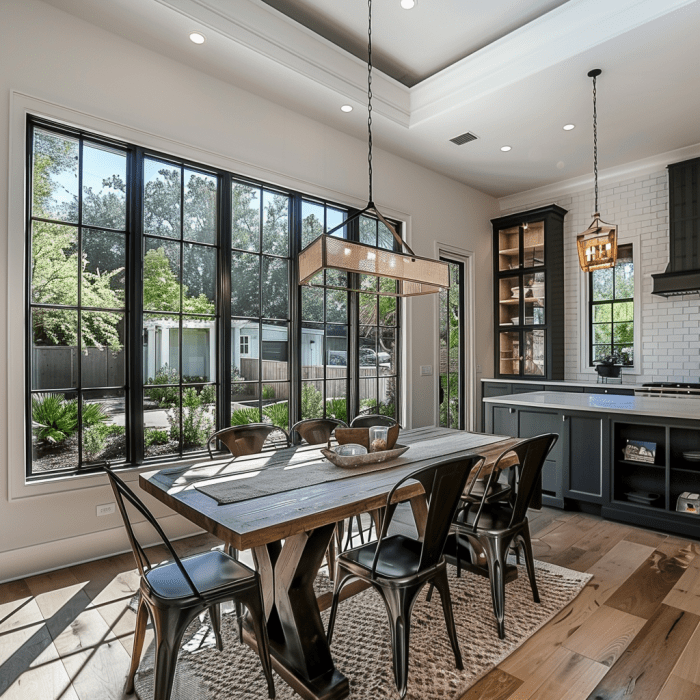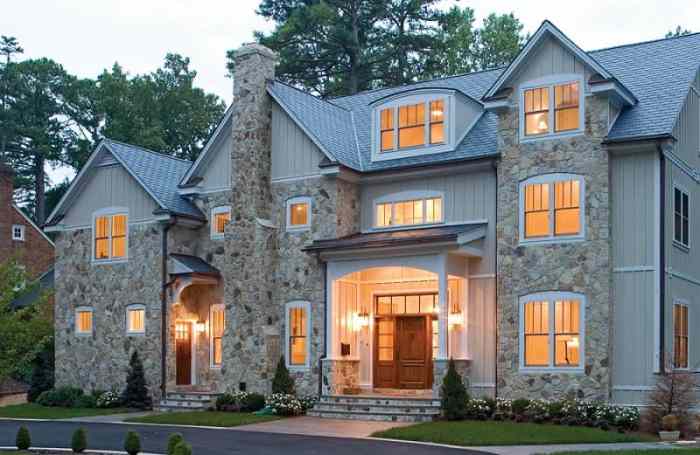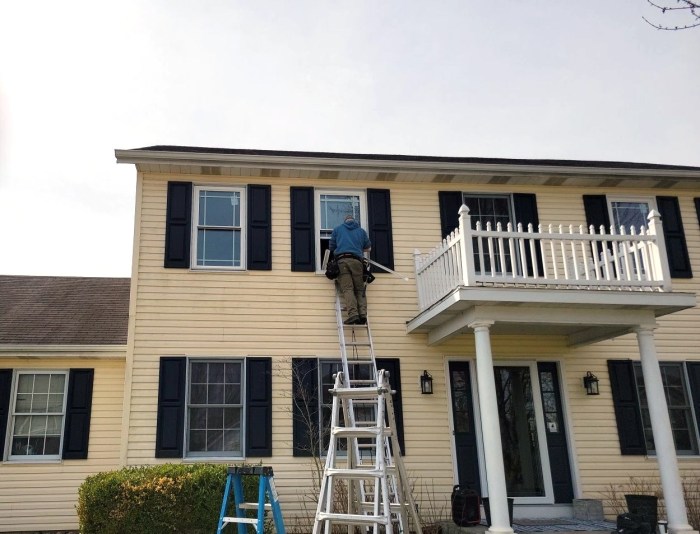Energy-efficient window replacements A homeowners guide – Energy-efficient window replacements: A homeowner’s guide. Thinking about upgrading your windows? It’s a smart move that can significantly impact your home’s comfort, energy bills, and even its resale value. This guide walks you through everything you need to know, from understanding the different types of energy-efficient windows to finding a reputable installer and maximizing your return on investment.
Let’s dive in and explore how you can transform your home with energy-saving windows.
Replacing your windows might seem like a big undertaking, but understanding the process and the benefits can make it much less daunting. We’ll cover the various window types, help you assess your current windows, guide you through the selection process, and even discuss financing options. By the end, you’ll be equipped to make informed decisions and enjoy a more comfortable, energy-efficient home.
Introduction to Energy-Efficient Windows
Replacing your windows can significantly impact your home’s energy efficiency and comfort. Energy-efficient windows reduce energy loss, leading to lower utility bills and a more comfortable living environment year-round. This translates to both cost savings and environmental benefits, making it a worthwhile investment for homeowners.Energy-efficient windows achieve these savings through several key features. These features work together to minimize heat transfer between your home and the outside environment, regardless of the season.
Understanding these features will help you choose the best windows for your needs and budget.
Types of Energy-Efficient Windows
Several window types offer superior energy efficiency compared to standard windows. The main differences lie in the number of panes, the gas fill between panes, and the application of low-emissivity (Low-E) coatings.
Window Features and Energy Savings
The following table compares the features and energy-saving capabilities of different window types. Note that actual energy savings will vary depending on factors like climate, window size, and installation quality.
| Window Type | Number of Panes | Gas Fill | Low-E Coating | Energy Savings Potential |
|---|---|---|---|---|
| Single-Pane | 1 | None | None | Low; significant heat transfer |
| Double-Pane | 2 | Argon or Krypton | Yes | Moderate; reduces heat transfer compared to single-pane |
| Triple-Pane | 3 | Argon or Krypton | Yes | High; minimizes heat transfer, ideal for extreme climates |
Double-pane windows are the most common type of energy-efficient window. They consist of two panes of glass separated by a gas-filled space, usually argon or krypton. These gases are better insulators than air, reducing heat transfer. Low-E coatings are microscopically thin, virtually invisible layers applied to one or more panes. These coatings reflect infrared radiation (heat) back into the house in winter and away from the house in summer.Triple-pane windows offer even greater energy efficiency than double-pane windows.
They have three panes of glass with two gas-filled spaces, further reducing heat transfer. They are a particularly good choice for homes in extremely hot or cold climates. While more expensive upfront, the long-term energy savings can be substantial, potentially paying for themselves over time.
Assessing Your Current Windows
Before you invest in new energy-efficient windows, it’s crucial to understand the condition and energy performance of your existing ones. This assessment will help you prioritize replacements and accurately estimate the potential savings from upgrading. A thorough evaluation will identify problem areas and guide your selection of appropriate replacement windows.Identifying windows in need of replacement involves a combination of visual inspection and performance testing.
Look for obvious signs of damage, such as cracks, rot, or broken seals. Pay close attention to how well the windows function; sticking frames, difficulty opening and closing, and excessive rattling are all indicators that a replacement might be necessary. Beyond physical damage, energy efficiency is a key factor to consider.
Signs of Inefficient Windows, Energy-efficient window replacements A homeowners guide
Inefficient windows often reveal themselves through noticeable drafts, condensation, or excessive heat loss/gain. Drafts can be felt near window frames or seals, often accompanied by a whistling sound. Condensation, particularly on the interior surface of the glass during colder months, suggests a problem with insulation and potential moisture buildup. Excessive heat loss in winter and heat gain in summer point towards poor insulation values and a need for improvement.
For example, if you consistently find yourself adjusting your thermostat frequently to compensate for temperature fluctuations near your windows, it’s a strong indicator of poor energy performance. Similarly, if your energy bills are unusually high compared to similar homes in your area, your windows might be a contributing factor.
Window Assessment Checklist
Before beginning your assessment, gather necessary tools: a flashlight, a thermometer, and a small piece of paper. The following checklist will guide you through a comprehensive evaluation of your windows:
- Visual Inspection: Examine each window frame for cracks, rot, peeling paint, or any signs of damage. Check for gaps or loose seals around the frame.
- Operation Test: Try opening and closing each window. Note any sticking, difficulty in operation, or rattling.
- Draft Detection: Hold a lit flashlight close to the window frame and look for light leaking through cracks or gaps. Alternatively, hold a piece of paper near the frame; if it’s sucked in, you have a draft.
- Condensation Check: Observe the windows for condensation, particularly during periods of high humidity or temperature differences. Condensation on the interior glass pane is a major sign of poor insulation.
- Temperature Measurement: Use a thermometer to measure the surface temperature of the window glass on both the interior and exterior sides. A significant difference indicates poor insulation. For example, a large temperature difference between the inside and outside glass surfaces suggests that heat is escaping easily.
- Energy Bill Review: Compare your energy bills from previous years to identify any unusual increases that may be attributable to poor window insulation. This requires some comparative analysis of your bills and consideration of other factors that might affect energy consumption.
Choosing the Right Replacement Windows: Energy-efficient Window Replacements A Homeowners Guide
Replacing your windows is a significant investment, so choosing the right ones is crucial for both energy efficiency and long-term satisfaction. This section will guide you through the key factors to consider when selecting replacement windows for your home, helping you make an informed decision. We’ll explore different window materials and their properties, ultimately enabling you to choose windows that best suit your needs and budget.
Window Material Comparison
The material you choose significantly impacts your windows’ energy efficiency, durability, and aesthetic appeal. Each material offers a unique blend of pros and cons.
- Vinyl: Vinyl windows are popular due to their affordability and low maintenance. They are excellent insulators and come in a wide variety of colors and styles. However, they may not be as durable as other materials and can be prone to warping in extreme temperatures if not of high quality.
- Wood: Wood windows offer superior insulation and a classic, elegant look. They can be customized to match any style, but require more maintenance than vinyl, including regular painting or staining to prevent rot and insect damage. High-quality wood windows are expensive but can last for decades.
- Fiberglass: Fiberglass windows combine the strength and durability of wood with the low maintenance of vinyl. They are excellent insulators and resist warping and fading. While more expensive than vinyl, they are generally less costly than high-end wood windows and offer a longer lifespan.
- Aluminum: Aluminum windows are durable and relatively inexpensive. However, they are poor insulators, leading to higher energy bills. They are often used in commercial settings but are less common in residential applications focused on energy efficiency.
Energy Ratings and Considerations
Beyond material, energy efficiency ratings are paramount. Look for windows with high U-factors (lower is better, indicating less heat transfer) and low Solar Heat Gain Coefficients (SHGC) (lower is better, indicating less solar heat entering your home). The National Fenestration Rating Council (NFRC) provides standardized ratings that allow for easy comparison between different window models. Consider your climate when evaluating these ratings; a window ideal for a hot climate might not be the best choice for a cold one.
For example, a window with a low SHGC might be perfect for Arizona, but could lead to a colder home in Minnesota.
Window Style and Design
Window style impacts both aesthetics and functionality. Consider the style that best complements your home’s architecture and your personal preferences. Common styles include double-hung, casement, sliding, awning, and bay windows. Each style offers different advantages in terms of ventilation, ease of cleaning, and light transmission. For instance, casement windows provide excellent ventilation, while bay windows add architectural interest and increase natural light.
Decision-Making Flowchart
This flowchart helps guide you through the window selection process:
- Determine your budget: Set a realistic budget for your window replacement project.
- Assess your energy needs: Consider your climate and energy efficiency goals.
- Choose your preferred window material: Weigh the pros and cons of vinyl, wood, fiberglass, and aluminum.
- Select desired window style: Consider aesthetics and functionality.
- Check NFRC ratings: Compare U-factors and SHGCs of different models.
- Get multiple quotes: Compare prices and services from different window installers.
- Make your final decision: Choose the windows that best meet your needs and budget.
The Installation Process
Professional window installation is a crucial step in ensuring your energy-efficient windows perform as expected. A poorly installed window, regardless of its quality, can lead to drafts, leaks, and reduced energy savings. This section details the process and provides guidance for homeowners.Proper installation requires precision and expertise. The process involves careful preparation, precise measurements, and meticulous attention to detail throughout each stage.
This ensures a secure, weathertight seal and optimal performance of your new windows. Failing to follow these steps can compromise the window’s energy efficiency and longevity.
Window Installer Selection Criteria
Choosing the right installer is as important as choosing the right windows. Homeowners should thoroughly research potential installers, checking reviews, licenses, and insurance. Verifying experience with similar projects and requesting references are crucial steps in this process. A reputable installer will provide a detailed contract outlining the scope of work, materials used, and payment schedule.
- Verify licensing and insurance: Confirm the installer holds the necessary licenses and insurance to protect both the homeowner and the installer.
- Check for experience: Inquire about the installer’s experience with similar window replacement projects and request references from previous clients.
- Review contracts carefully: Ensure the contract clearly Artikels the scope of work, materials, payment schedule, warranty details, and dispute resolution procedures.
- Obtain multiple quotes: Compare quotes from at least three different installers to ensure competitive pricing and identify the best value for your investment.
- Ask about cleanup procedures: Inquire about the installer’s cleanup procedures to minimize disruption during and after the installation process.
Step-by-Step Installation Guide
The following steps Artikel a typical professional window installation process. Remember, this is a general guide, and specific steps may vary depending on the window type and existing framing conditions. Always follow the installer’s instructions and recommendations.
- Preparation: [Illustration: A worker carefully measuring the window opening with a tape measure. Caption: Precise measurements are critical for a proper fit. Incorrect measurements can lead to gaps and drafts.] This stage involves protecting the surrounding area with drop cloths and removing any obstacles. The installer will also double-check the window dimensions against the opening to ensure a precise fit.
- Removal of Old Windows: [Illustration: A worker carefully removing an old window frame using pry bars and other tools. Caption: Removing old windows requires care to avoid damaging the surrounding structure. The installer should work methodically to ensure the safe removal of the old frame.] This involves carefully removing the old window frame, taking care not to damage the surrounding wall or window trim. Any debris or damaged materials are removed.
- Framing Adjustments (if necessary): [Illustration: A worker adjusting the window frame using shims and other tools to ensure a proper fit and level installation. Caption: Shims are used to ensure a level and plumb installation, creating a solid foundation for the new window.] This step may be required to address any discrepancies between the new window and the existing frame. Shims are used to ensure a level and plumb installation.
- Installation of New Windows: [Illustration: A worker carefully placing a new window into the opening and securing it with screws and fasteners. Caption: The new window is carefully installed, ensuring proper alignment and a secure fit. Caulk and sealant are used to create a weathertight seal.] The new window is carefully placed into the opening and secured using screws and fasteners. Caulk and sealant are applied to create a weathertight seal around the frame.
- Finishing Touches: [Illustration: A worker applying caulk and sealant around the newly installed window frame. Caption: Caulk and sealant create a waterproof and airtight seal, preventing drafts and energy loss.] This includes cleaning up the area, installing trim, and ensuring the window operates smoothly.
Calculating Return on Investment (ROI)
Replacing your windows with energy-efficient models is a significant investment, but the potential long-term savings can make it a worthwhile undertaking. Calculating your return on investment (ROI) will help you determine if this upgrade aligns with your financial goals. This involves comparing the upfront costs of new windows with the anticipated reduction in your energy bills over time.Understanding the factors influencing your ROI is crucial.
This includes the initial cost of the windows, your current energy rates, the energy efficiency ratings of your chosen windows (like U-factor and SHGC), and the climate you live in. Higher energy costs and colder/hotter climates generally lead to faster ROI. The type of window you select—double-pane, triple-pane, or those with additional features like low-E coatings—will also significantly impact your savings.
Energy Savings Calculation
To estimate your potential energy savings, you’ll need to determine your current annual energy costs related to heating and cooling, which are largely influenced by window efficiency. You can usually find this information on your utility bills. Next, research the energy efficiency ratings (U-factor and Solar Heat Gain Coefficient or SHGC) of the replacement windows you are considering.
Lower U-factors indicate better insulation, reducing heat loss in winter and heat gain in summer. Lower SHGC values mean less solar heat enters your home in summer. Many window manufacturers provide this data on their websites or product brochures. Using this information, along with estimates of energy savings provided by the manufacturer or energy auditor, you can project your annual energy cost reduction.
For example, if your current annual heating and cooling costs are $1500 and the new windows are projected to save 25%, your annual savings would be $375.
ROI Calculation Example
Let’s consider two scenarios:Scenario 1: A homeowner replaces 10 windows with double-pane, low-E windows at a cost of $10,
- Their projected annual energy savings are $
- To calculate the simple payback period, divide the initial cost by the annual savings: $10,000 / $500 = 20 years. This means it will take 20 years for the energy savings to cover the initial investment.
Scenario 2: The same homeowner opts for triple-pane windows with advanced coatings, costing $15,000. The projected annual energy savings increase to $750. The simple payback period is $15,000 / $750 = 20 years. While the upfront cost is higher, the increased energy savings maintain a similar payback period. Note that these are simplified calculations; a more comprehensive ROI analysis would incorporate factors like the windows’ lifespan and potential resale value increase.
Comparison of Window Options and ROI
The following table compares upfront costs and long-term savings for various window options. These figures are illustrative and will vary based on factors mentioned previously.
| Window Type | Upfront Cost (per window) | Estimated Annual Energy Savings (per window) | Approximate Payback Period (years) |
|---|---|---|---|
| Single-pane | $100 | $10 | 10 |
| Double-pane | $300 | $50 | 6 |
| Triple-pane | $500 | $100 | 5 |
| Double-pane with Low-E coating | $400 | $75 | 5.3 |
Maintenance and Care
Proper maintenance of your energy-efficient windows is crucial for maximizing their lifespan and ensuring they continue to deliver on their promise of energy savings. Neglecting regular care can lead to decreased efficiency, costly repairs, and a shorter overall lifespan for your windows. A little preventative maintenance goes a long way in preserving your investment.Regular cleaning and occasional inspections will help you identify and address minor issues before they escalate into major problems.
This proactive approach will not only save you money in the long run but also contribute to the overall comfort and aesthetic appeal of your home.
Window Cleaning Techniques
Cleaning your windows correctly is essential for maintaining their clarity and energy efficiency. Dirty windows can significantly reduce the amount of natural light entering your home, forcing you to rely more on artificial lighting and increasing your energy consumption. A simple cleaning routine can prevent this. Start by gently removing loose dirt and debris with a soft brush or cloth.
Then, use a mixture of warm water and a mild detergent, applying it with a soft sponge or microfiber cloth. Avoid harsh chemicals or abrasive cleaners, as these can damage the window coatings and seals. Finally, rinse thoroughly with clean water and dry with a clean, lint-free cloth or squeegee for a streak-free finish. For hard-to-reach areas, consider using a telescopic window cleaner.
Common Window Problems and Solutions
Several common issues can affect the performance and longevity of your energy-efficient windows. Addressing these problems promptly is vital for preserving their energy-saving capabilities.
- Condensation: Excessive condensation between the window panes indicates a potential seal failure. This compromises the insulating properties of the window. Contact a window repair professional for assessment and repair. Proper ventilation in your home can also help minimize condensation.
- Drafty Windows: Feeling drafts around your windows suggests air leaks. Check for gaps or cracks around the frame. Caulk or weatherstrip any openings to improve insulation and prevent air infiltration. For more significant air leaks, professional assessment may be necessary.
- Damaged Seals: Damaged seals around the window frame or between panes can lead to reduced energy efficiency and potential water damage. Repairing or replacing damaged seals is essential to restore the window’s performance. A window repair professional can assess the damage and recommend the appropriate solution.
- Sticking or Jammed Windows: Windows that stick or jam can be caused by debris, paint build-up, or warping of the frame. Lubricate the moving parts with silicone-based lubricant to improve functionality. If the problem persists, professional assistance may be required.
- Foggy or Cloudy Windows: Fogginess or cloudiness between the window panes indicates a broken seal, allowing moisture to enter the insulated space. This significantly reduces the window’s energy efficiency. Replacement is often the most effective solution.
Importance of Regular Maintenance for Energy Efficiency
Regular window maintenance is not merely about aesthetics; it’s a critical factor in preserving the energy efficiency of your windows. By addressing minor issues promptly and maintaining a clean window surface, you can prevent significant energy loss and save money on your utility bills. Regular inspections allow for early detection of problems, preventing them from escalating into costly repairs.
A well-maintained window system will contribute to a more comfortable and energy-efficient home environment for years to come. For example, a home with consistently well-maintained windows might see a 10-15% reduction in heating and cooling costs compared to a home with neglected windows, depending on the climate and the severity of the neglect.
Financing Options

Source: windowsourcehouston.com
Replacing your windows is a significant investment, but several financing options can make it more manageable. Understanding these options and their implications is crucial to making an informed decision. This section explores various financing methods, highlighting their advantages and disadvantages to help you choose the best fit for your budget and circumstances.
Upgrading to energy-efficient windows is a great home improvement project, boosting comfort and saving you money on your energy bills. But remember, a well-insulated home is a whole system; exterior elements matter too. For instance, if you’re dealing with stucco damage, you might want to check out this helpful guide: Stucco Repair Contractors A Comprehensive Guide.
Addressing exterior issues alongside window replacements ensures maximum energy efficiency and improves your home’s overall value.
The cost of energy-efficient window replacements varies widely depending on factors such as window size, type, material, and the number of windows being replaced. Therefore, securing appropriate financing is often essential. Fortunately, several avenues exist to help offset the initial expense.
Loans
Loans provide upfront capital to cover the entire cost of window replacement. This allows you to complete the project immediately and begin enjoying the benefits of energy savings. However, loans accrue interest over time, increasing the overall cost. Different types of loans exist, including home equity loans (using your home’s equity as collateral), personal loans (unsecured), and potentially even specialized financing options offered by window companies or contractors.
It’s crucial to compare interest rates and repayment terms from multiple lenders to secure the most favorable deal. For example, a home equity loan might offer a lower interest rate but carries the risk of losing your home if you default on the loan. A personal loan offers flexibility but usually comes with a higher interest rate.
Upgrading to energy-efficient windows is a great home improvement project, boosting comfort and lowering energy bills. But remember, curb appeal matters too! Check out Professional Landscaping Services A Comprehensive Guide for ideas on enhancing your home’s exterior. After all, beautiful landscaping complements energy-efficient windows, creating a truly inviting and sustainable home.
Rebates and Tax Credits
Many utility companies and government agencies offer rebates and tax credits to homeowners who install energy-efficient upgrades, including windows. These incentives directly reduce the upfront cost or provide a tax deduction, making the project more affordable. The availability and amount of these incentives vary by location and program. For example, a homeowner in California might qualify for a state rebate program while a homeowner in New York might benefit from a federal tax credit.
To find available programs, you can check your local utility company’s website, your state’s energy office website, and the website of the Department of Energy (DOE). These resources often have searchable databases to help you locate relevant programs in your area.
Thinking about boosting your home’s energy efficiency? Energy-efficient window replacements are a great place to start. Improving your home’s exterior significantly impacts its overall energy performance, and that’s where projects like those detailed in Exterior Home Remodeling Ideas Transform Your Home come in. By upgrading windows, you’ll see a noticeable difference in your energy bills, complementing other exterior improvements.
Energy Efficiency Financing Programs
Some specialized financing programs focus specifically on energy efficiency upgrades. These programs often offer attractive terms and conditions, potentially including lower interest rates or longer repayment periods. These programs may be administered by state or local governments, utility companies, or non-profit organizations. For example, a local utility company might offer a zero-interest loan specifically for energy-efficient window replacements to encourage energy conservation within their service area.
Energy-efficient window replacements are a great first step in improving your home’s energy performance. Reducing heat loss through windows significantly impacts your energy bills, and these savings can then be further boosted by investing in renewable energy sources. For a comprehensive guide on maximizing those savings, check out this resource on Solar Panel Installation A Comprehensive Guide , which can help you understand how solar panels can work with your upgraded windows to create a truly efficient home.
Ultimately, combining energy-efficient windows with solar power offers substantial long-term benefits.
Contacting your local utility company or searching online for “energy efficiency financing [your state/city]” is a good starting point to discover these options.
Finding Reputable Installers

Source: cgwindow.com
Choosing the right installer is just as crucial as choosing the right windows. A poor installation can negate the energy efficiency benefits of even the highest-quality windows, leading to drafts, leaks, and higher energy bills. Taking the time to find a reputable installer will save you money and headaches in the long run.Finding a qualified and trustworthy window installer requires thorough research and careful vetting.
This involves more than just checking online reviews; it demands a proactive approach to ensure you’re working with professionals who prioritize quality workmanship and customer satisfaction. This section provides guidance on how to identify and select the right installer for your window replacement project.
Checking References and Licensing
Before committing to any installer, it’s vital to verify their credentials and track record. Request a list of references from at least three previous clients and contact them to inquire about their experiences. Inquire about the timeline of the project, the quality of the work, and whether the installer addressed any issues promptly and professionally. Furthermore, confirm that the installer holds the necessary licenses and insurance for operating in your area.
This protects you from potential liability in case of accidents or substandard work. Many states require contractors to have licenses, and these licenses are often publicly accessible online through the state’s contractor licensing board. Insurance, including liability and workers’ compensation, demonstrates a commitment to responsible business practices and protects you from financial repercussions in the event of on-site incidents.
Asking Key Questions to Potential Installers
Asking the right questions can reveal a lot about an installer’s professionalism and competence. Here’s a checklist of essential questions to ask potential installers:
- How long have you been in business?
- Can you provide proof of licensing and insurance?
- Do you have experience installing the type of windows I’ve chosen?
- What is your process for handling potential problems or damage during installation?
- Can you provide a detailed written estimate that Artikels all costs and materials?
- What is your warranty policy, and what does it cover?
- What is your typical timeline for completing a project of this size?
- Can you provide references from recent clients who have had similar window installations?
- What is your policy on cleanup after the installation is complete?
- Are your employees trained and experienced in proper window installation techniques?
Avoiding Window Installation Scams
Unfortunately, the window replacement industry isn’t immune to scams. Be wary of installers who:
- Pressure you into making a quick decision.
- Offer unusually low prices without a clear explanation.
- Demand full payment upfront.
- Lack a physical address or business license.
- Have inconsistent or vague answers to your questions.
- Don’t provide a detailed written contract.
If anything feels off, trust your instincts and seek a second opinion. It’s better to take your time and find a reputable installer than to rush into a deal that could cost you more in the long run. Remember, a thorough vetting process is crucial for a successful and trouble-free window replacement project.
Epilogue

Source: energyefficientreplacements.com
Upgrading to energy-efficient windows is an investment in your home’s future, offering significant long-term savings on energy bills and increased comfort. By carefully considering the factors Artikeld in this guide – from choosing the right window type to selecting a qualified installer – you can ensure a successful project that enhances your home’s value and reduces your environmental footprint.
Remember, a well-informed decision leads to a more comfortable and cost-effective home. So, start planning your energy-efficient window replacement project today!
Essential Questionnaire
What is the average lifespan of energy-efficient windows?
The lifespan varies depending on the material and quality, but generally, you can expect energy-efficient windows to last 15-20 years or even longer with proper maintenance.
Can I install energy-efficient windows myself?
While possible for some simpler installations, professional installation is generally recommended for optimal performance, warranty coverage, and to avoid potential damage to your home.
How do I clean energy-efficient windows without damaging the coatings?
Use a soft cloth, mild detergent, and warm water. Avoid abrasive cleaners or harsh chemicals that could scratch the low-E coatings.
Are there any government rebates or tax credits available for energy-efficient window replacements?
Yes, many local, state, and federal programs offer rebates or tax credits for energy-efficient home improvements. Check with your local utility company and government websites for details.
What’s the difference between double-pane and triple-pane windows?
Triple-pane windows offer superior insulation compared to double-pane windows due to the extra layer of glass and gas fill, leading to greater energy savings but at a higher initial cost.


